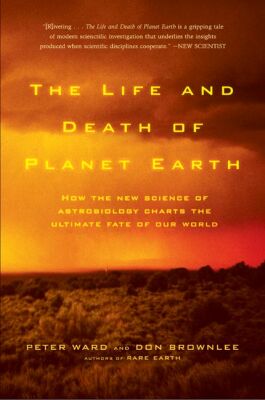

| THE LIFE AND DEATH OF PLANET EARTH How the New Science of Astrobiology Charts the Ultimate Fate of our World Peter D. Ward Donald Brownlee New York: Times Books, 2002 |
Rating: 4.0 High |
|||
| ISBN-13 978-0-8050-6781-1 | ||||
| ISBN 0-8050-6781-7 | 240p. | HC/BWI | $25.00 | |
Scientists have been extracting cylindrical cores from the deep ice sheets that cover Greenland and Antarctica. These ice cores reveal a startling story about the climate of our world: For most of the past 100 centuries the temperature was declining slowly. Then, about 11,000 years ago, the climate warmed abruptly, leaving us in the pleasant — and unusual — interglacial period we now enjoy.
It is now clear that such interglacials are the exception during the past two million years. The record in the ice is unmistakable: Every 100,000 years the temperature plunges; snow and ice accumulate, and glaciers advance to cover what we think of as temperate latitudes.1 This cold period lasts approximately 90,000 years. Over the following 10,000 years, typically, the world slowly warms. Glaciers retreat, and the lands we call North America and Europe once again support life in plenty.
Drawing on the latest work of many scientists, paleontologist Peter Ward and astronomer Donald Brownlee warn that we may be on the brink of another glaciation. They present a graph2 showing temperature data for the past 400,000 years. The brief peaks of interglacial periods are clearly evident, as is the fact that our interglacial has lasted longer than most.
Once the world does cool down, the authors contend, humankind will be in trouble. There would be much less land for the population of 6 billion souls, and of what land remained free of the ice, many formerly fertile areas would be desert. The projected results: Mass starvation, millions of refugees, and almost certainly wars over what arable land and other resources are left.
But that is merely the first and mildest calamity they project. About 250 million years from now, continental drift will bring the major land masses3 back together to reunite the ancient supercontinent Gondwanaland. Ocean currents such as the Gulf Stream will be disrupted. The depths of the stagnant, anoxic oceans will be devoid of life, but may hold vast quantities of methane and carbon dioxide. Those gases might erupt4 into the atmosphere, leading to a runaway greenhouse effect. Otherwise, the large land mass would experience greater temperature extremes than today's, and increased weathering of its rocks could deplete carbon dioxide. Starved of a prime nutrient, photosynthesizing plant life would die off at some point. Without vegetation, the land would warm even further. Animals would survive after the death of higher plants for a time. Billions of years of life would remain for the Sun, but its light would also be gradually getting stronger. Ultimately life would disappear from the land, the oceans would be lost to space, and only brine-loving bacteria would persist in the few moist spots that remain.
The authors paint a gloomy picture of our future, based on the latest scientific projections. But the thing to remember about these projections is that they are very much works in progress; new data and theories may well modify them, and might even turn them upside down. Also, note that the authors make no mention of human intervention in these dire events. It is my projection that, within a short time in comparison to the geological time scales the authors consider, human civilization will be able to change the amount of sunlight hitting a planet, either deflecting some with sunshades or increasing it with giant mirrors. This capability comes under the general heading of terraforming, defined as modifying a planet's surface environment to make it habitable by humans. The authors touch on such concepts, mentioning the idea of moving Earth farther from the Sun. However, they don't believe that would ever be practical.5 Neither do they believe our species will ever live on the other planets of this solar system. They are equally dismissive of interstellar travel, citing its immense costs in energy and time. I won't bother to analyze their arguments in detail; they come down to saying that because we haven't done those things yet, we never will be able to do them. All this nay-saying is contained in Chapter 13, The Great Escape, which ends with these words (pages 207-8):
Interstellar travel will likely never happen, meaning we are stranded in this solar system forever. We are also likely to be permanently stuck on Earth. It is our oasis in space, and the present is our very special place in time. Humans should enjoy and cherish their day in the Sun on a very special planet and not dwell too seriously on thoughts of unicorns, minotaurs, mermaids, and the Starship Enterprise. |
Our experience on Earth is probably repeated endlessly in the cosmos. Life develops on planets but is ultimately destroyed by the light of a slowly brightening star. It is a cruel fact of nature that life-giving stars always go bad. |
Translation: "Don' worry... Be happy..." Sorry, gentlemen; I don't sing that tune.
Like Rare Earth, their previous book, The Life and Death of Planet Earth is in general well-written and illustrated, extensively researched, and imparts a lot of information. Its list of sources includes 173 references, and it has a thorough index. However, it suffers from similar instances of vague and contradictory predictions, and contains a greater than usual quantity of errors. (For example, the authors devote several pages to the Drake Equation, but what they call its original form is in fact the modified version developed by Frank Drake and the late Carl Sagan.) I'll recommend it for reading, but not as a keeper.

 To contact Chris Winter, send email to this address.
To contact Chris Winter, send email to this address.